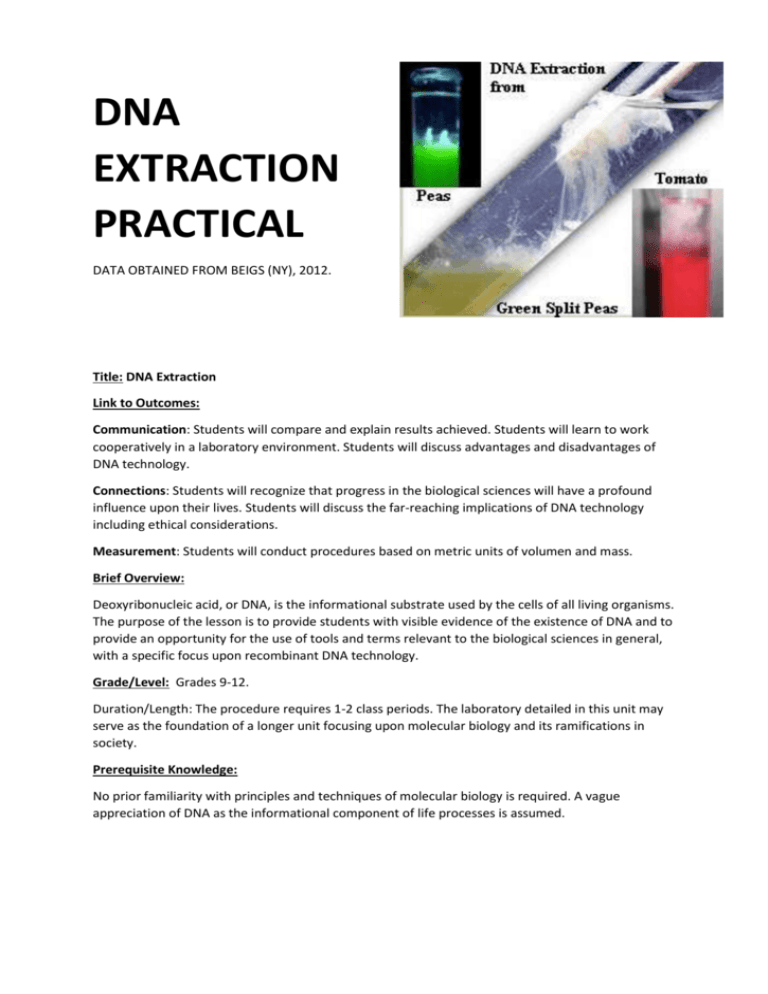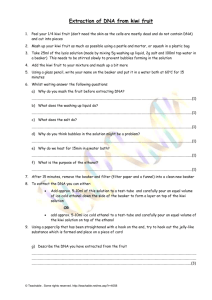DNA Extraction Lab Protocol for High School Biology
advertisement

DNA EXTRACTION PRACTICAL DATA OBTAINED FROM BEIGS (NY), 2012. Title: DNA Extraction Link to Outcomes: Communication: Students will compare and explain results achieved. Students will learn to work cooperatively in a laboratory environment. Students will discuss advantages and disadvantages of DNA technology. Connections: Students will recognize that progress in the biological sciences will have a profound influence upon their lives. Students will discuss the far-reaching implications of DNA technology including ethical considerations. Measurement: Students will conduct procedures based on metric units of volumen and mass. Brief Overview: Deoxyribonucleic acid, or DNA, is the informational substrate used by the cells of all living organisms. The purpose of the lesson is to provide students with visible evidence of the existence of DNA and to provide an opportunity for the use of tools and terms relevant to the biological sciences in general, with a specific focus upon recombinant DNA technology. Grade/Level: Grades 9-12. Duration/Length: The procedure requires 1-2 class periods. The laboratory detailed in this unit may serve as the foundation of a longer unit focusing upon molecular biology and its ramifications in society. Prerequisite Knowledge: No prior familiarity with principles and techniques of molecular biology is required. A vague appreciation of DNA as the informational component of life processes is assumed. Objectives: The students will have the opportunity to extract DNA for visualization and to discuss the scientific, economic, and social potentials of such technology. Materials/Resources/Printed Materials: Fruit sample, cutting board, knife Blender, Hot water bath or hot plate Hooked glass stirring rod One large beaker, cheesecloth, rubber band One small test tube One medium-sized bottle Contact lens enzymatic cleaning tablet (containing papain) Ice bucket Graduated cylinder Ethanol (12 ml), 95% 500 ml homogenization media (25g SDS, 4.4 g NaCl, 2.2g sodium citrate, 0.15g EDTA, in distilled water) Development/Procedures: 1. Discuss the procedures to be performed, including discussions of the relevance of each solution and mechanical operation employed in DNA extraction. Briefly, heating and blending serve to break down the onion tissues and denature (inactivate) enzymes which would cut DNA. The components of the homogenization media break down the cell walls as well as the cellular and nuclear membranes of onion cells. Papain is a protease enzyme which will denature proteins which bind to DNA, causing the DNA to increase in flexibility. Alcohol is added to precipitate DNA from solution. 2. Chop the fruit finely, putting the pieces into a large beaker and covering with homogenization media preheated to 60 degrees Celsius. 3. Place the beaker in a 60 degree water bath and shake or stir frequently over a 5 minute period. 4. Cool the beaker in ice water. 5. Blend the fruit pieces and homogenization media in a blender. 6. Filter the blended fruit into a large beaker covered with cheesecloth held in place by a rubber band. Place 15 ml of this filtrate into a bottle of medium size. 7. Dissolve the contact cleaning tablet in 3 ml of distilled water in a test tube and add to the filtrate, mixing gently. 8. Add 12 ml of cold ethanol to the mixture of filtrate and contact cleaner, allowing the ethanol to flow down the inside of the filtrate bottle. 9. Observe the DNA rise into the alcohol layer as a cloudy suspension of white strings. Spool the DNA onto the hooked glass rod and allow the DNA to air dry. Results: DNA sample source Strawberry Plum Apple Banana Kiwi Split peas Tomato Sample amount (g) 0.20 0.15 0.15 0.22 0.20 0.32 0.27 DNA yield (ng/ul) 125 100 75 56 112 110 88 Authors: Dr. Carolyn Brooks Dr. Mark Estienne Barry Hoopengardner UMES UMES University of Connecticut Somerset County Somerset County







